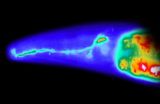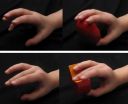INFORMATION:
Lousto and Healy visualized the black holes' flip-flopping tango in a short animation. The mini-movie, produced at the Black Hole Lab in RIT's Center for Computational Relativity and Gravitation, is set to Invierno Porteño by Argentine tango composer Ástor Piazzolla. END
Flip-flopping black holes spin to the end of the dance
Scientists at RIT study dynamics of spinning black holes
2015-04-09
(Press-News.org) When black holes tango, one massive partner spins head over heels (or in this case heels over head) until the merger is complete, said researchers at Rochester Institute of Technology in a paper published in Physical Review Letters.
This spin dynamic may affect the growth of black holes surrounded by accretion disks and alter galactic and supermassive binary black holes, leading to observational effects, according to RIT scientists Carlos Lousto and James Healy.
The authors of the study will present their findings at the American Physical Society meeting in Baltimore on April 14 and celebration of the Centennial of General Relativity.
Lousto and Healy, postdoctoral researcher at RIT, use sophisticated numerical techniques to solve Einstein's equations of gravity and simulate black hole interactions on supercomputers. The specialized field known as numerical relativity grew from the general theory of relativity, first published in November 1915.
"We study binary spinning black holes to display the long-term individual spin dynamics," said Lousto, professor in RIT's School of Mathematical Sciences and a member of the Center for Computational Relativity and Gravitation.
In their paper, "Flip-flopping binary black holes," Lousto and Healy numerically simulated equal-mass black holes and studied the individual alignment and direction of spin as the black holes approached merger. The binary black holes flirted for nearly 48 orbits, three precession cycles, and half of a flip-flop cycle.
"Lousto and Healy's simulation is one of the longest ever attempted for spinning black hole binaries," said Pedro Marronetti, National Science Foundation physics division program director. "Their results and potential observational effects will impact research in a wide range of areas, from gravitational physics to galactic evolution and cosmology."
Key to their findings is that one black hole in the simulation totally changes the orientation of its spin. Its initial alignment with the orbital angular momentum changes to a complete anti-alignment after half of a flip-flop cycle, Lousto said.
The researchers compared this evolution with post-Newtonian equations of motion and spin evolution and deciphered maximum flip-flop angles and frequencies.
"We show that this process continuously flip-flops the spin during the lifetime of the binary until merger," Lousto said.
ELSE PRESS RELEASES FROM THIS DATE:
NASA sees Tropical Cyclone Joalane's winds consolidate around its eye
2015-04-09
The RapidScat instrument that flies aboard the International Space Station (ISS) provided data about Tropical Cyclone Joalane's surface winds that showed how the strongest sustained winds consolidated as the tropical cyclone intensified and developed an eye. As of April 9, warnings were in effect at Rodrigues Island in the Southern Indian Ocean as Joalane approached.
RapidScat measured the surface winds within Tropical Cyclone Joalane late on April 7 and on April 8, revealing that the strongest winds consolidated over a 24 hour period. RapidScat measured Joalane's winds ...
In the sea, a deadly form of leukemia is catching
2015-04-09
Outbreaks of leukemia that have devastated some populations of soft-shell clams along the east coast of North America for decades can be explained by the spread of cancerous tumor cells from one clam to another. Researchers call the discovery, reported in the Cell Press journal Cell on April 9, 2015, "beyond surprising."
"The evidence indicates that the tumor cells themselves are contagious--that the cells can spread from one animal to another in the ocean," said Stephen Goff of the Howard Hughes Medical Institute and Columbia University. "We know this must be true because ...
Brain activity in infants predicts language outcomes in autism spectrum disorder
2015-04-09
Autism spectrum disorder (ASD) can produce strikingly different clinical outcomes in young children, with some having strong conversation abilities and others not talking at all. A study published by Cell Press April 9th in Neuron reveals the reason: At the very first signs of possible autism in infants and toddlers, neural activity in language-sensitive brain regions is already similar to normal in those ASD toddlers who eventually go on to develop good language ability but nearly absent in those who later have a poor language outcome.
"Why some toddlers with ASD get ...
Stem cell disease model clarifies bone cancer trigger
2015-04-09
Using induced pluripotent stem cells (iPSCs), a team led by Mount Sinai researchers has gained new insight into genetic changes that may turn a well known anti-cancer signaling gene into a driver of risk for bone cancers, where the survival rate has not improved in 40 years despite treatment advances.
The study results, published today in the journal Cell, revolve around iPSCs, which since their 2006 discovery have enabled researchers to coax mature (fully differentiated) bodily cells (e.g. skin cells) to become like embryonic stem cells. Such cells are pluripotent, able ...
How the brain balances risk-taking and learning
2015-04-09
LA JOLLA--If you had 10 chances to roll a die, would you rather be guaranteed to receive $5 for every roll ($50 total) or take the risk of winning $100 if you only roll a six?
Most animals, from roundworms to humans, prefer the more predictable situation when it comes to securing resources for survival, such as food. Now, Salk scientists have discovered the basis for how animals balance learning and risk-taking behavior to get to a more predictable environment. The research reveals new details on the function of two chemical signals critical to human behavior: dopamine--responsible ...
Mutation causes mice to behave as if they have an eating disorder
2015-04-09
A genetic mutation associated with an increased risk of developing eating disorders in humans has now been found to cause several behavioral abnormalities in mice that are similar to those seen in people with anorexia nervosa. The findings, published online April 9 in Cell Reports, may point to novel treatments to reverse behavioral problems associated with disordered eating.
"It's been known for a long time that about 50% to 70% of the risk of getting an eating disorder was inherited, but the identity of the genes that mediate this risk is unknown," explains senior author ...
Touch-sensing neurons are multitaskers
2015-04-09
Two types of touch information -- the feel of an object and the position of an animal's limb -- have long been thought to flow into the brain via different channels and be integrated in sophisticated processing regions. Now, with help from a specially devised mechanical exoskeleton that positioned monkeys' hands in different postures, Johns Hopkins researchers have challenged that view. In a paper published in the April 22 issue of Neuron, they present evidence that the two types of information are integrated as soon as they reach the brain by sense-processing brain cells ...
Ocean myth busted: 'Toddler' sea turtles are very active swimmers
2015-04-09
It turns out sea turtles, even at a tender 6-18 months of age, are very active swimmers. They don't just passively drift in ocean currents as researchers once thought. NOAA and University of Central Florida researchers say it's an important new clue in the sea turtle "lost years" mystery. Where exactly turtles travel in their first years of life, before returning to coastal areas as adults to forage and reproduce, has puzzled scientists for decades.
"All species of sea turtles are endangered or threatened under the Endangered Species Act; knowing their distribution is ...
Gene loss creates eating disorder-related behaviors in mice
2015-04-09
Building on their discovery of a gene linked to eating disorders in humans, a team of researchers at the University of Iowa has now shown that loss of the gene in mice leads to several behavioral abnormalities that resemble behaviors seen in people with anorexia nervosa.
The team, led by Michael Lutter, MD, PhD, assistant professor of psychiatry in the UI Carver College of Medicine, found that mice that lack the estrogen-related receptor alpha (ESRRA) gene are less motivated to seek out high-fat food when they are hungry and have abnormal social interactions. The effect ...
Can facial plastic surgery make you more likeable?
2015-04-09
WASHINGTON -- Facial plastic surgery may do more than make you look youthful. It could change -- for the better -- how people perceive you. The first study of its kind to examine perception after plastic surgery finds that women who have certain procedures are perceived as having greater social skills and are more likeable, attractive and feminine.
The study is not superficial -- the importance of facial appearance is rooted in evolution and studies suggest that judging a person based on his or her appearance boils down to survival. The results were published online ...
LAST 30 PRESS RELEASES:
Interaction of climate change and human activity and its impact on plant diversity in Qinghai-Tibet plateau
From addressing uncertainty to national strategy: an interpretation of Professor Lim Siong Guan’s views
Clinical trials on AI language model use in digestive healthcare
Scientists improve robotic visual–inertial trajectory localization accuracy using cross-modal interaction and selection techniques
Correlation between cancer cachexia and immune-related adverse events in HCC
Human adipose tissue: a new source for functional organoids
Metro lines double as freight highways during off-peak hours, Beijing study shows
Biomedical functions and applications of nanomaterials in tumor diagnosis and treatment: perspectives from ophthalmic oncology
3D imaging unveils how passivation improves perovskite solar cell performance
Enriching framework Al sites in 8-membered rings of Cu-SSZ-39 zeolite to enhance low-temperature ammonia selective catalytic reduction performance
AI-powered RNA drug development: a new frontier in therapeutics
Decoupling the HOR enhancement on PtRu: Dynamically matching interfacial water to reaction coordinates
Sulfur isn’t poisonous when it synergistically acts with phosphine in olefins hydroformylation
URI researchers uncover molecular mechanisms behind speciation in corals
Chitin based carbon aerogel offers a cleaner way to store thermal energy
Tracing hidden sources of nitrate pollution in rapidly changing rural urban landscapes
Viruses on plastic pollution may quietly accelerate the spread of antibiotic resistance
Three UH Rainbow Babies & Children’s faculty elected to prestigious American Pediatric Society
Tunnel resilience models unveiled to aid post-earthquake recovery
Satellite communication systems: the future of 5G/6G connectivity
Space computing power networks: a new frontier for satellite technologies
Experiments advance potential of protein that makes hydrogen sulfide as a therapeutic target for Alzheimer’s disease
Examining private equity’s role in fertility care
Current Molecular Pharmacology achieves a landmark: real-time CiteScore advances to 7.2
Skeletal muscle epigenetic clocks developed using postmortem tissue from an Asian population
Estimating unemployment rates with social media data
Climate policies can backfire by eroding “green” values, study finds
Too much screen time too soon? A*STAR study links infant screen exposure to brain changes and teen anxiety
Global psychiatry mourns Professor Dan Stein, visionary who transformed mental health science across Africa and beyond
KIST develops eco-friendly palladium recovery technology to safeguard resource security
[Press-News.org] Flip-flopping black holes spin to the end of the danceScientists at RIT study dynamics of spinning black holes





